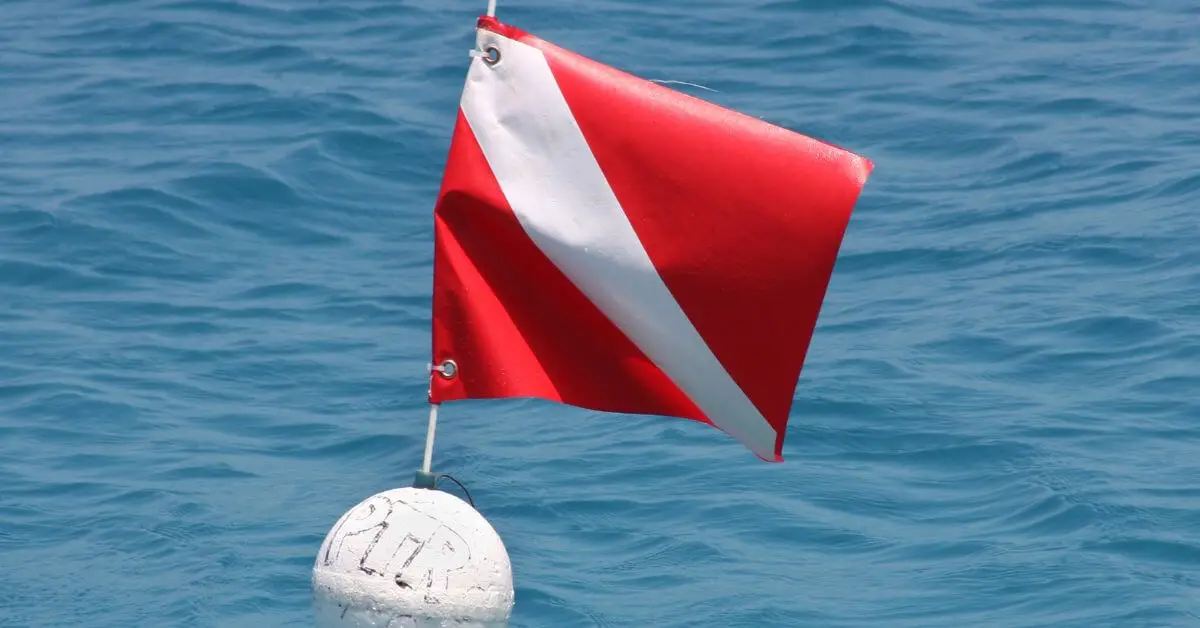Scuba divers and water enthusiasts grasp the necessity of safety while diving into the underwater realm. A crucial instrument that guarantees their security is the Dive Flag, also known as the Diver Down Flag or scuba flags. This unmistakable flag is a critical warning sign to inform fellow boaters about the presence of divers below.
In this article, we will dive into the specifics of the Dive Flag: its importance and how it elevates the safety of diving expeditions. Whether you’re an experienced diver or merely fascinated by the world beneath the water, comprehending the utility and significance of dive flags is crucial to your underwater experience.
History of the Diver Down Flag
The Diver Down Flag was born in the mid-20th century, a time when there was a need for a uniform diving signal. Initially featuring a blue background with a white stripe, its design evolved over time to what we now recognize as red with a white stripe. This significant transformation in design made the flag universally identifiable.
Originally intended to avoid underwater mishaps, the flag became a globally acknowledged symbol for diving operations. Its functionality extended beyond regional limitations to ensure the safety of divers worldwide. Today, it serves as a universal icon for divers’ safety across various geographical locations.
Different regions have unique variations of the flag design based on local laws and traditional practices. Such as the Alpha Flag used in North America. These flags and the red and white Diver Down Flag offer an added degree of safety for divers. Now, recreational and professional diving operations widely accept the protocol of using the Diver Down flag as a safety measure.
Types of Dive Flags
Dive flags, identifiable by their unique styles and sizes, play crucial roles in diving activities. Comprehending the variety of dive flags facilitates safety for divers and boaters and fosters seamless underwater communication. Let’s dive deeper into understanding these flags:
1. Blue and White (Alpha Flag)
Often referred to as the “Diver Down” flag, the Alpha flag is the most internationally recognized dive flag. The Alpha flag, distinct from the Red Diver Down Flag, boasts a unique design.
This flag, bearing a blue and white color pattern with a distinguishing diagonal white stripe, is an international symbol denoting the presence of divers beneath the water’s surface. When flown alone, this “A” flag or international code flag sends a clear message to nearby watercraft. That there is active diving in the vicinity, and a safe distance should be maintained.
The Alpha flag is often coupled with the Red and White “Diver Down” flag for enhanced safety. This combination helps underscore the presence of divers in the water.
2. Red Flag with White Stripe (Diver Down Flag)
The Red Scuba Flag garners immediate recognition among water enthusiasts across the United States. This rectangular red flag adorned with a white diagonal stripe serves a cardinal function: to signal that divers are in the water, thus ensuring security.
The birth of the Red Scuba Flag can be traced back to Navy veteran Denzel James Dockery, whose vision in the 1950s led to the flag’s creation. The intention was clear – to inform boat operators about the presence of divers in the water.
The flag garnered considerable acclaim, especially with Ted Nixon, founder of US Divers, who realized the flag’s critical role in safeguarding those involved in diving operations.
Diving Operations & Regulations: Understanding Diver Flag Rules
Navigating diving operations and regulations involves understanding the importance of dive flags governed by the International Maritime Organization (IMO) and local authorities. Ensuring these flags are visible and follow specific standards is crucial for maintaining safety in the water.
International Maritime Organization (IMO) Guidelines for Dive Flags
The IMO stipulates that dive flags should adhere to certain measurements to guarantee visibility and effectiveness. The minimum recommended size for a dive flag is 60 cm by 60 cm (24 inches by 24 inches), with an ideal size of 90 cm by 90 cm (36 inches by 36 inches). The flag should be hoisted at the vessel’s highest point for maximum visibility.
A standard dive flag — the Alpha Flag — should be rectangular, featuring a blue background with a white diagonal stripe running from the top left to the bottom right corner.
Display Requirements
A dive flag must be mounted on a flagpole or a buoy to be highly visible to other boaters. The flag should be elevated at least one meter (3 feet) above the highest part of the vessel or buoy. Furthermore, keeping the flag upright and unfurled is essential to easily recognize it from a distance.
Additional Guidelines and Regulations
Aside from IMO guidelines, divers and boaters should familiarize themselves with local dive flag regulations. Some regions may impose specific requirements, such as additional flag signals or restrictions on diving activities. Adhering to these regulations is vital for maintaining a safe and harmonious diving environment.
U.S. Coast Guard Rules and Regulations for Dive Flags
The U.S. Coast Guard mandates that divers in U.S. waters display a diver-down warning device when submerged. This device can be a flag, buoy, or distinguishable mark compliant with certain specifications. A red flag with a white diagonal stripe – known as the “divers-down” symbol – is required to run from the top-left corner to the bottom-right corner.
The U.S. Coast Guard also specifies size and design provisions. The recommended dimensions for a dive flag are a minimum size of 20 inches by 24 inches, with a relative increase for larger vessels. This is essential for the flag’s visibility to other boaters and helps prevent accidents.
Display Requirements
Boat operators must reasonably maintain at least 300 feet of distance from diver-down warning devices in open water. And at least 100 feet away in rivers, inlets, or navigation channels. Those approaching closer than these distances must slow down to idle speed.
It is vital to note that dive flags should not be displayed when divers are out of open water, as this may cause confusion. The dive flag must be removed or stowed away once divers exit the water and are safely on board.
Conclusion
Diver-down flags hold a crucial role in safeguarding dive operations. Boat captains are responsible for displaying a diver down flag conspicuously. Ensuring that other vessels can easily spot the flag and be aware of divers in the water.
When employed correctly and in compliance with local regulations, diver’s flags help mitigate accidents and injuries by alerting boats and other watercraft to the presence of divers in the targeted area.
To maximize safety, divers must:
- Thoroughly understand the various types of flags and their meanings.
- Learn how to properly use these flags in accordance with appropriate guidelines.
- Obtain necessary training and adhere to safety measures.
- Utilize the right equipment to prevent accidents and guarantee a secure diving experience.
Incorporating the use of diver-down flags and other safety precautions in diving activities is vital to protecting both divers and those participating in water-related pursuits. By adhering to proper guidelines, divers can relish their experiences while minimizing the likelihood of accidents and injuries.








